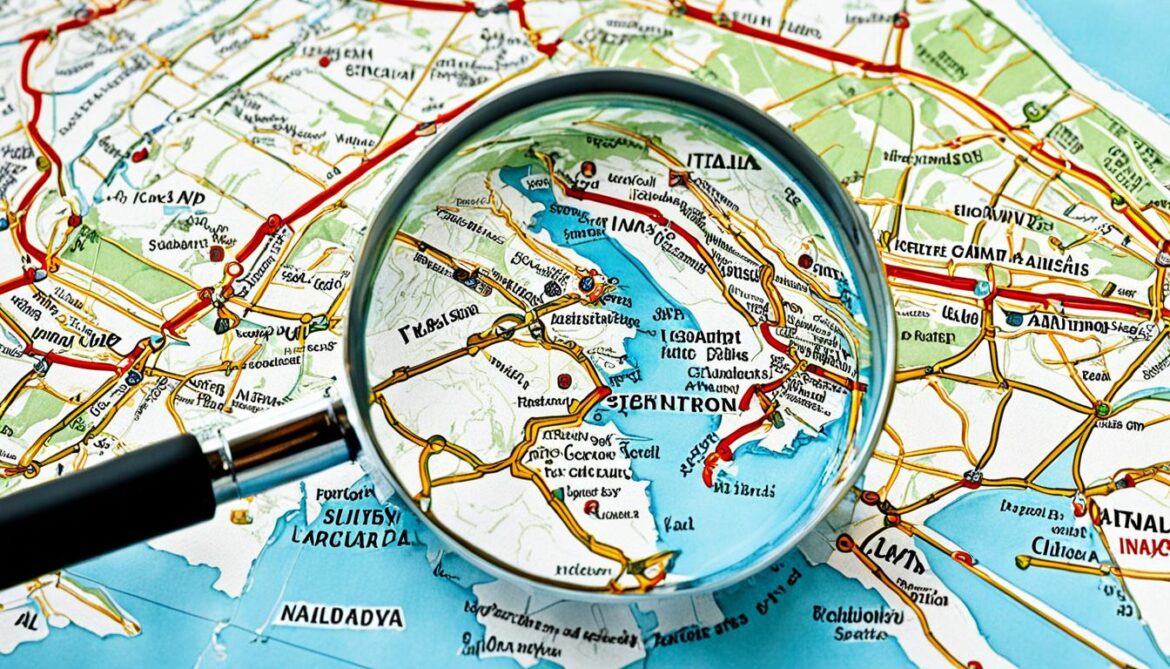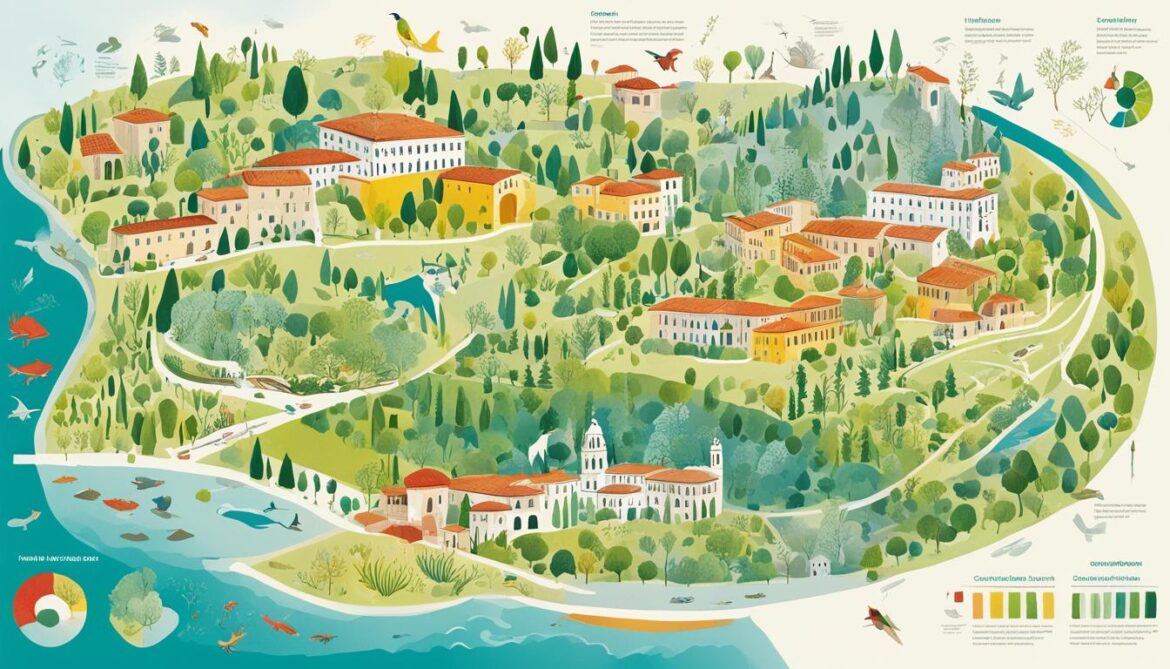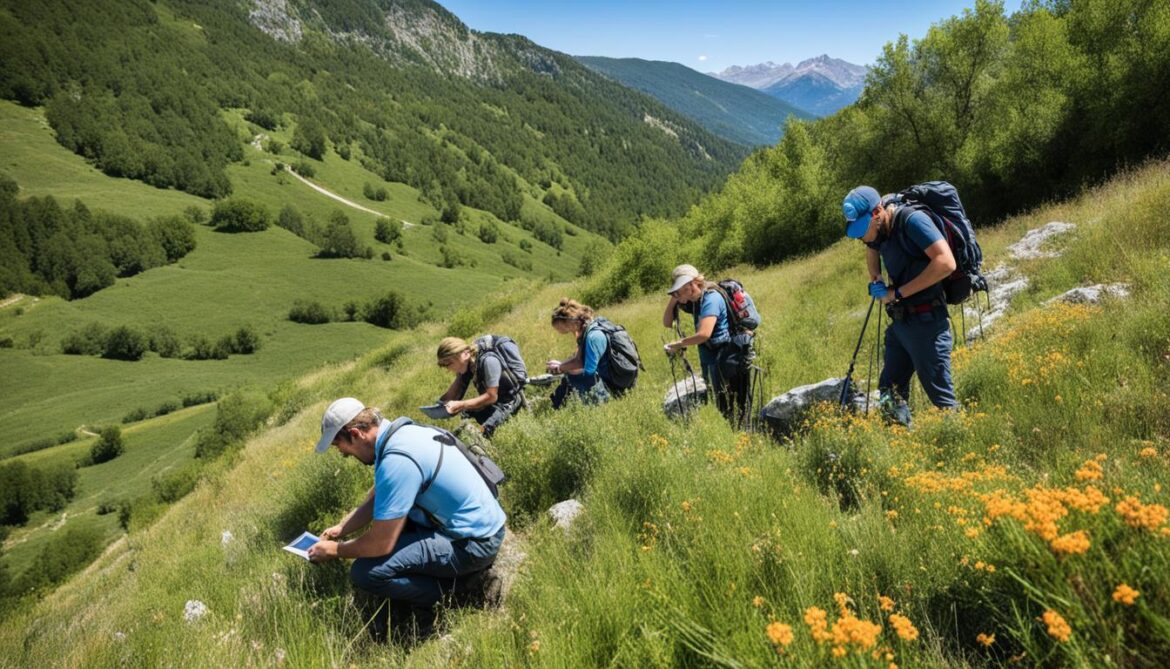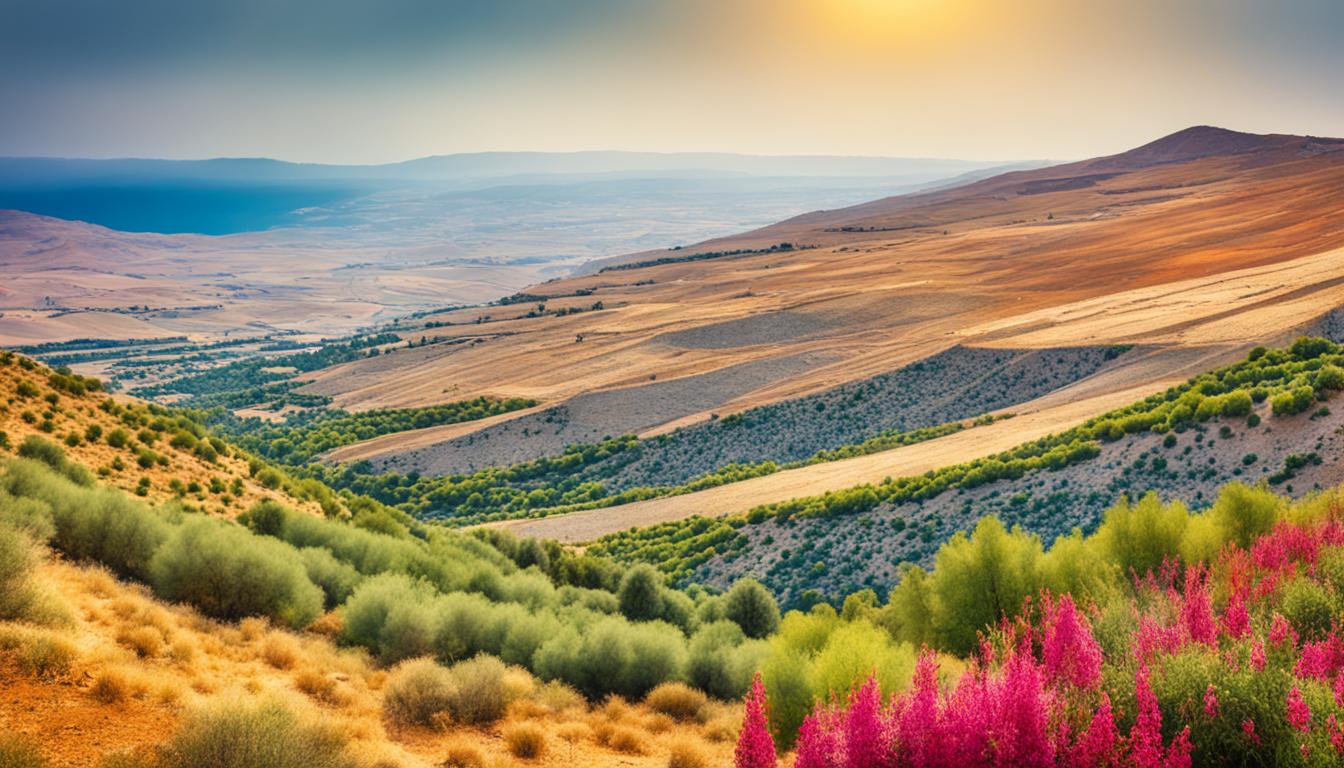Italy Sacred Natural Sites and Biodiversity
Did you know that sacred natural sites (SNS) have been recognized as the oldest form of habitat protection in human history? These sites, with their spiritual significance for people and communities, play a vital role in biodiversity conservation.
Italy, with its rich cultural and natural heritage, is home to a diverse range of SNS. These Italian Sacred Natural Areas contribute to the preservation of both cultural heritage and ecological diversity. From sacred groves to wildlife sanctuaries, these sites protect habitats and provide refuge for endemic, threatened, and rare species.
In this article, we will explore the importance of sacred natural sites, the effectiveness of SNS in biodiversity conservation, the geographical and taxonomical bias in SNS research, and the ongoing initiatives in SNS research and conservation in Italy. Let’s dive deeper into the world of Italy’s sacred natural sites and their role in preserving biodiversity.
Key Takeaways:
- Sacred natural sites (SNS) are the oldest form of habitat protection in human history and have a positive effect on biodiversity conservation.
- Italy is home to a diverse range of SNS, including sacred groves and wildlife sanctuaries.
- Efforts are needed to address the geographical and taxonomical bias in SNS research.
- Integrating SNS into conservation frameworks is crucial for the preservation of cultural heritage and ecological diversity.
- Ongoing initiatives in SNS research and conservation demonstrate Italy’s commitment to protecting these valuable sites.
The Importance of Sacred Natural Sites
Sacred natural sites (SNS) hold a significant place in human history as the oldest form of land and water conservation. These areas, often associated with majestic natural features like trees, mountains, and rivers, hold profound spiritual significance for communities worldwide.
SNS play a crucial role in biodiversity conservation. They act as sanctuaries, providing vital habitats for endemic, threatened, and rare species. In highly modified landscapes, SNS can be the only remaining patches of natural or semi-natural habitats.
One of the key contributions of SNS to conservation is the preservation of old-growth trees and forest patches. These undisturbed areas sustain unique microclimates and provide refuge to a plethora of flora and fauna.
Moreover, SNS hold cultural and ecological values that are passed down through generations. The spiritual significance of these sites contributes to their conservation value, ensuring the maintenance of traditional ecological knowledge and practices.
By recognizing the importance of SNS and integrating them into conservation frameworks, we can protect not only the biodiversity they harbor but also preserve the cultural heritage and spiritual connections they represent.
“Sacred sites are not only places of worship, but also places of conservation. They remind us of the sacredness of nature and our inherent connection to it.”
To illustrate the vital role SNS play in biodiversity conservation, let’s delve into a few examples:
| Example | Location | Conservation Impact |
|---|---|---|
| Mount Kailash | Tibet | Preserves unique alpine ecosystems and rare species |
| Uluru-Kata Tjuta National Park | Australia | Holds spiritual and ecological significance for Indigenous communities and protects critical habitats |
| Mauna Kea | Hawaii | Hosts endemic species and fragile ecosystems |
These examples highlight the diverse range of SNS worldwide and their essential contributions to biodiversity conservation. By valuing and protecting these sacred sites, we can ensure the continued existence of both remarkable natural landscapes and the rich cultural tapestry they encompass.
Effectiveness of Sacred Natural Sites
Research has demonstrated the profound effectiveness of sacred natural sites (SNS) in promoting biodiversity conservation. These unique sites contribute significantly to the enhancement of taxonomical diversity, supporting a wide array of species, including both endemic and specialist species. Through their conservation efforts, SNS not only safeguard these valuable species but also preserve the intricate vegetation structure of their surroundings, which includes the protection of old-growth trees and forest patches.
The positive influence of SNS extends beyond the preservation of biodiversity, encompassing the cultural uses of natural resources by local communities. By respecting and recognizing the spiritual significance of SNS, communities are encouraged to engage in sustainable practices, ensuring the long-term preservation of these natural resources. It is through the active conservation of SNS that the art of harmonizing cultural heritage and ecological diversity can be achieved.
“Sacred natural sites promote the sustainable use of natural resources and contribute to a harmonious coexistence between humans and nature.” – Dr. Maria Rossi, Environmentalist
SNS and Taxonomical Diversity
Sacred natural sites play a crucial role in the conservation of taxonomical diversity. By providing a sanctuary for a diverse range of species, including those that are endemic and specialist, SNS support the proliferation and continuity of unique genetic lineages. This rich taxonomical diversity is essential for maintaining the delicate balance of ecosystems and preserving the resilience of the natural world.
SNS and Vegetation Structure
The impact of sacred natural sites on vegetation structure cannot be underestimated. These sites serve as havens for the preservation of old-growth trees and forest patches, safeguarding critical habitats for numerous species. The intact vegetation structure maintained within SNS contributes to healthy ecosystem functioning, including the provision of various ecosystem services and the mitigation of climate change.
“Sacred natural sites represent irreplaceable ecological treasures that hold the key to sustaining our planet’s biodiversity and mitigating environmental challenges.” – Professor Luca Bianchi, Ecologist

The effectiveness of sacred natural sites in promoting biodiversity conservation highlights the urgent need to recognize and conserve these invaluable areas within appropriate conservation frameworks. By integrating SNS into our conservation efforts, we can secure a future where cultural heritage, ecological diversity, and sustainable practices coexist harmoniously.
Geographic and Taxonomical Bias in SNS Research
When examining the research on sacred natural sites (SNS), it becomes apparent that there is a significant geographical and taxonomical bias. The majority of studies have predominantly focused their investigations on SNS in Asia and Africa. This geographical bias has resulted in a limited understanding of SNS in other continents, hindering our comprehension of their role in biodiversity conservation.
Additionally, there is a taxonomical bias in the research, with a majority of studies primarily focusing on plants. This narrow focus limits our understanding of SNS in relation to other taxonomic groups, such as animals, fungi, and microorganisms. To gain a comprehensive understanding of the effectiveness and potential of SNS for conservation, it is vital to address these biases.
A more inclusive approach is required, with an emphasis on conducting research in underrepresented regions and taxa. By expanding the scope of SNS research, we can gain a more comprehensive picture of their role in biodiversity conservation and broaden our understanding of the unique ecological dynamics within different geographical settings.
The integration of SNS research across various continents and taxonomic groups will allow us to identify patterns, similarities, and differences in the ecological functioning and conservation value of SNS worldwide.
“Expanding the scope of SNS research beyond Asia and Africa will provide valuable insights into the global significance of sacred natural sites for biodiversity conservation.”
The Role of SNS Research in Asia and Africa
SNS research conducted in Asia and Africa has played a significant role in establishing the positive impact of these sites on biodiversity conservation. Studies in these regions have highlighted the importance of SNS in preserving and protecting threatened and endemic species, maintaining vegetation structure, and promoting cultural uses of biodiversity.
However, it is crucial to acknowledge that this geographical bias can create misleading perceptions about the effectiveness and potential of SNS for conservation in other parts of the world. By diversifying research efforts and conducting studies in underrepresented regions, we can ensure a more comprehensive and accurate understanding of the role of SNS in biodiversity conservation.
Expanding Research to Address Bias
To address the geographical and taxonomical bias in SNS research, it is essential to prioritize studies in regions outside of Asia and Africa. By conducting research in other continents, such as Europe, the Americas, and Oceania, we can gain a broader perspective on the ecological functioning and conservation value of SNS across diverse landscapes.
Furthermore, researchers should venture beyond plants and explore the role of SNS in supporting and conserving various taxonomic groups. By investigating the influence of SNS on animal species, microorganisms, and fungi, we can better understand the overall ecological dynamics and conservation potential of these sites.
Improving our Understanding of SNS for Conservation
Expanding research beyond geographical and taxonomical biases in SNS studies will significantly enhance our understanding of the role of SNS in biodiversity conservation.
A more comprehensive and inclusive approach to SNS research will allow conservationists, policymakers, and communities to make informed decisions regarding the protection and management of these sites worldwide.

Sacred Natural Sites in Italy
Italy is blessed with a wealth of sacred natural sites (SNS) that hold profound spiritual significance for local communities. These sites, encompassing both land and water, serve as sanctuaries of cultural heritage and ecological diversity.
Within Italy’s SNS, you will find a diverse array of natural features, including ancient groves and forest patches, each carrying its own unique spiritual essence. These sacred sites are intertwined with the daily lives and beliefs of the people who consider them sacred, fostering a deep connection between humanity and nature.
Italy also boasts designated wildlife sanctuaries that contribute to the conservation of biodiversity. These protected areas play a vital role in maintaining ecological balance and preserving habitats for a wide array of plant and animal species, many of which are native and endemic to the region.
Recognizing and conserving these sacred natural sites in Italy is of utmost importance. By doing so, we are safeguarding not only the cultural heritage and spiritual values but also the unique ecological diversity that these sacred landscapes hold. It is a harmonious blend of human reverence and environmental stewardship, paving the way for a sustainable future for both the present and future generations.

Preserving Italy’s Sacred Natural Sites
“The conservation of sacred natural sites in Italy is not just about protecting the physical landscapes; it is about cherishing the intangible connections we share with nature, the living entities that coexist with us.”
Preserving Italy’s sacred natural sites requires a collaborative and holistic approach. It involves working hand in hand with local communities, government agencies, and conservation organizations to ensure the sustainable management and protection of these invaluable places.
The integration of scientific research, traditional ecological knowledge, and modern conservation practices is key to developing effective strategies for the preservation of these sites. By understanding the ecological dynamics and cultural significance of each SNS, we can tailor conservation efforts to meet the specific needs of both the natural environment and the communities that depend on them.
Furthermore, creating awareness and appreciation for Italy’s sacred natural sites among the general public is crucial. By educating and engaging individuals, we can foster a sense of responsibility and a shared commitment to the conservation of these sacred landscapes.
The Role of Sacred Natural Sites in Italy’s Future
As we navigate the challenges of a rapidly changing world, Italy’s sacred natural sites serve as anchors of stability, offering solace, inspiration, and a deeper connection with the natural world. These sites have the power to shape our collective consciousness and guide us towards a more sustainable future.
By recognizing and protecting these sacred landscapes, Italy can set an example for the world in harmonizing cultural heritage preservation and ecological conservation. This harmonious coexistence will not only benefit the unique biodiversity of the Italian peninsula but also inspire similar efforts worldwide, fostering a global movement of reverence and respect for nature.
| Sacred Natural Sites | Key Features |
|---|---|
| Monte Sant’Angelo in Puglia | A sacred cave believed to be the dwelling place of Archangel Michael, attracting religious pilgrims and nature enthusiasts alike. |
| Monte Orsaro in Lombardy | A mountain peak with ancient ruins, surrounded by pristine forests and hiking trails, offering breathtaking panoramic views. |
| Bosco Sacro di San Francesco in Tuscany | A sacred woodland associated with the life and teachings of Saint Francis of Assisi, providing a serene retreat for contemplation and reflection. |
| Lago di Montepulciano in Umbria | A tranquil lake nestled amidst rolling hills, symbolizing the interconnectedness of water, life, and spirituality. |
Integrating Sacred Natural Sites into Conservation Frameworks
The positive effects of sacred natural sites (SNS) on biodiversity conservation highlight the need to integrate SNS into conservation frameworks. In Italy, efforts are being made to recognize and conserve SNS as part of the country’s nature conservation strategies.
“Integrating SNS into conservation frameworks ensures the long-term preservation of cultural heritage and ecological diversity in Italy,” says Dr. Luca Bianchi, a renowned conservation biologist.
Recognizing the importance of SNS, Italy has developed specific forms of governance and policies to support their conservation. Through effective management practices, SNS can be successfully integrated into existing conservation frameworks, fostering a harmonious balance between human activities and nature preservation.
One such initiative in Italy is the Conservare per il Futuro (Conserving for the Future) program that focuses on the conservation of Italian SNS. The program brings together government agencies, local communities, and environmental organizations to develop comprehensive conservation strategies for these sacred sites.
Benefits of Integrating SNS into Conservation Frameworks
Integrating SNS into conservation frameworks offers numerous benefits for both biodiversity and cultural heritage preservation. By recognizing and conserving SNS, Italy can:
- Promote the protection and restoration of unique habitats and wildlife species
- Preserve traditional ecological knowledge and cultural practices
- Strengthen local community participation and sustainable resource management
- Enhance tourism opportunities by showcasing the rich cultural and natural heritage of Italy

Best Practices for SNS Management in Italy
To effectively manage SNS in Italy, a collaborative approach is crucial. The integration of traditional knowledge, scientific research, and community engagement is essential for successful SNS conservation. Key best practices for SNS management in Italy include:
- Establishing clear legal frameworks that recognize the cultural, spiritual, and ecological significance of SNS
- Engaging local communities and indigenous groups in decision-making processes and land stewardship
- Implementing monitoring and adaptive management strategies to ensure the long-term viability of SNS
- Developing educational programs and awareness campaigns to promote the value of SNS
- Collaborating with research institutions and conservation organizations to enhance knowledge and conservation efforts
By incorporating these best practices into SNS management strategies, Italy can ensure the continued conservation and protection of its sacred natural sites for future generations.
Urban Sacred Natural Sites in Italy
Italy not only boasts stunning natural landscapes but also urban areas that are home to sacred natural sites (SNS) contributing to biodiversity conservation. These urban green spaces not only provide havens for wildlife but also offer cultural benefits to communities. Unfortunately, urbanization poses increasing threats to these sites. Nonetheless, recognizing and protecting urban SNS, such as Swayambhu, Meiji Jingu, Ambohimanga, and Krakus Mound, is crucial for conserving biodiversity and preserving spiritual values.

Urban SNS in Italy, like their rural counterparts, make significant contributions to the preservation of biodiversity. They provide vital habitats for a variety of species and act as corridors for wildlife movement in urban environments. These sites also offer spiritual and cultural values, serving as peaceful sanctuaries amid the hustle and bustle of city life.
“Urban sacred natural sites in Italy serve as havens for biodiversity in the midst of urbanization, preserving nature and providing spiritual solace to city dwellers.”
In addition to their spiritual and cultural significance, urban SNS provide valuable ecosystem services. They help mitigate urban pollution by filtering air and water, improving the quality of the urban environment. These sites also play a role in regulating temperature, reducing the urban heat island effect, and providing green spaces for recreation and relaxation.
Recognizing and protecting urban sacred natural sites in Italy is essential for maintaining ecological balance within urban environments. It requires collaborative efforts from the government, local communities, and environmental organizations to develop conservation strategies, ensure proper management, and raise awareness about the importance of these sites.
Benefits of Urban Sacred Natural Sites in Italy
| Benefits | Description |
|---|---|
| Biodiversity Conservation | Urban SNS provide habitats and corridors for a variety of species, preserving biodiversity in urban environments. |
| Spiritual and Cultural Values | These sites offer spiritual solace and maintain cultural heritage, providing spaces for reflection and connection to nature. |
| Ecosystem Services | Urban SNS contribute to pollution control, temperature regulation, and the provision of green spaces for recreation and relaxation. |
By recognizing and protecting urban sacred natural sites, Italy can embrace its cultural heritage, preserve biodiversity, and create sustainable and livable cities for future generations.
Challenges and Opportunities in SNS Conservation
The conservation of sacred natural sites (SNS) presents both challenges and opportunities. Understanding the distribution and characteristics of SNS remains incomplete, causing uncertainties around their legal status and role in official conservation schemes. Additionally, conflicts between SNS and human communities sometimes arise. However, these challenges can be addressed to enhance SNS conservation.
Opportunities exist to improve SNS conservation efforts. Increasing awareness of the importance of SNS is crucial. By integrating SNS into land planning and conservation approaches, their preservation can be prioritized. Furthermore, fostering multi-stakeholder partnerships for SNS management will facilitate collaborative efforts.
“Conservation of sacred natural sites presents challenges, but opportunities arise through increased awareness, integration into land planning, and partnership building.”
Addressing these challenges and seizing opportunities will enhance SNS conservation strategies, ensuring the continued preservation of these sacred sites and the ecosystems they protect.
Challenges and Opportunities in SNS Conservation
| Challenges | Opportunities |
|---|---|
| 1. Incomplete knowledge of SNS distribution and characteristics | 1. Increased awareness of the importance of SNS |
| 2. Uncertainties about legal status and role in conservation schemes | 2. Integration of SNS into land planning and conservation approaches |
| 3. Conflicts between SNS and human communities | 3. Promotion of multi-stakeholder partnerships for SNS management |
By addressing these challenges and leveraging opportunities, conservation efforts for sacred natural sites can be strengthened, leading to the continued protection and preservation of these unique and culturally significant areas.

Current Initiatives in SNS Research and Conservation in Italy
In Italy, several ongoing initiatives are dedicated to the research and conservation of sacred natural sites (SNS), showcasing the country’s commitment to preserving these significant areas. These projects aim to investigate the influence of SNS on biodiversity and ethnobotanical knowledge, shedding light on their ecological value.
These initiatives involve close collaborations between esteemed universities, research institutions, and the Italian Ministry of University and Research. By working together, these entities contribute to a comprehensive understanding of SNS in Italy, paving the way for the development of effective conservation strategies.
Through these initiatives, researchers delve into the intricate relationship between SNS and biodiversity, unraveling the profound impact these sacred sites have on the natural world.
The research conducted as part of these projects not only enhances our knowledge of SNS in Italy but also provides valuable insights on how to safeguard these unique areas for future generations. The findings inform conservation efforts by offering guidance on sustainable practices and resource management.
By investing in SNS research and conservation, Italy emphasizes the importance of preserving its natural heritage and recognizing the invaluable role that sacred sites play in maintaining ecological diversity.

Italian SNS Conservation Initiatives:
- Collaborative efforts involving universities, research institutions, and the Italian Ministry of University and Research
- Focus on investigating the influence of SNS on biodiversity and ethnobotanical knowledge
- Contributing to a comprehensive understanding of SNS in Italy
- Development of effective conservation strategies
- Guidance on sustainable practices and resource management
Conclusion
The richness of Italy’s sacred natural sites (SNS) and biodiversity underscores the significance of conserving these remarkable places. Recognized as the oldest form of habitat protection, SNS have a positive impact on biodiversity conservation across continents. However, there is a geographic and taxonomic bias in SNS research, with a focus on Asia and Africa and predominantly on plants.
It is crucial to bridge these gaps and further our understanding of SNS. Integrating SNS into conservation frameworks, including urban areas, is essential for preserving Italy’s cultural heritage and ecological diversity. Ongoing initiatives in SNS research and conservation demonstrate a strong commitment to safeguarding these invaluable sites. By prioritizing the recognition and conservation of SNS, Italy can continue to reap the spiritual and ecological benefits they provide.
The conservation of Italy’s sacred natural sites has far-reaching implications, encompassing Italy’s sacred natural areas, biodiversity conservation, sacred landscapes, nature conservation, wildlife sanctuaries, environmental protection, ecological diversity, and the management of wild areas. By protecting these precious sites, Italy can ensure the long-term preservation of its natural and cultural treasures.








